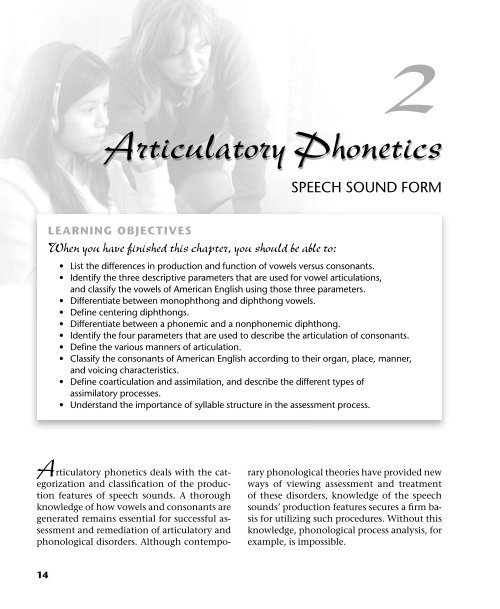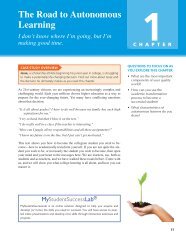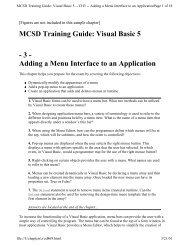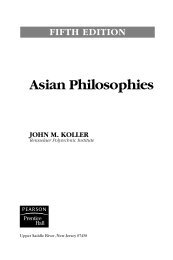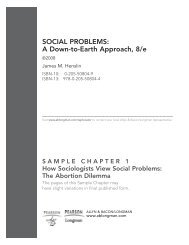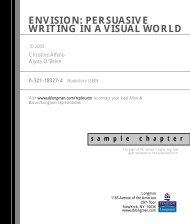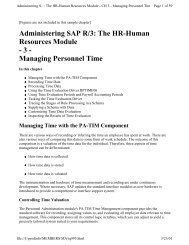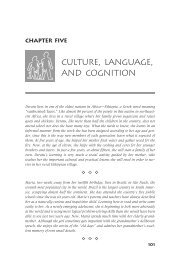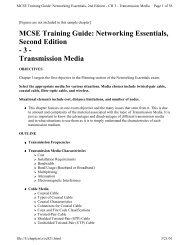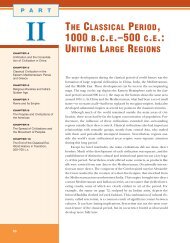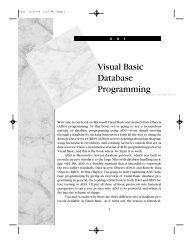Chapter 2: Articulatory Phonetics
Chapter 2: Articulatory Phonetics
Chapter 2: Articulatory Phonetics
Create successful ePaper yourself
Turn your PDF publications into a flip-book with our unique Google optimized e-Paper software.
14 CHAPTER 2<br />
<strong>Articulatory</strong> phonetics deals with the categorization<br />
and classifi cation of the production<br />
features of speech sounds. A thorough<br />
knowledge of how vowels and consonants are<br />
generated remains essential for successful assessment<br />
and remediation of articulatory and<br />
phonological disorders. Although contempo-<br />
14<br />
<strong>Articulatory</strong> <strong>Phonetics</strong><br />
LEARNING OBJECTIVES<br />
When you have fi nished this chapter, you should be able to:<br />
•<br />
•<br />
•<br />
•<br />
•<br />
•<br />
•<br />
•<br />
•<br />
•<br />
2<br />
SPEECH SOUND FORM<br />
List the differences in production and function of vowels versus consonants.<br />
Identify the three descriptive parameters that are used for vowel articulations,<br />
and classify the vowels of American English using those three parameters.<br />
Differentiate between monophthong and diphthong vowels.<br />
Defi ne centering diphthongs.<br />
Differentiate between a phonemic and a nonphonemic diphthong.<br />
Identify the four parameters that are used to describe the articulation of consonants.<br />
Defi ne the various manners of articulation.<br />
Classify the consonants of American English according to their organ, place, manner,<br />
and voicing characteristics.<br />
Defi ne coarticulation and assimilation, and describe the different types of<br />
assimilatory processes.<br />
Understand the importance of syllable structure in the assessment process.<br />
rary phonological theories have provided new<br />
ways of viewing assessment and treatment<br />
of these disorders, knowledge of the speech<br />
sounds’ production features secures a fi rm basis<br />
for utilizing such procedures. Without this<br />
knowledge, phonological process analysis, for<br />
example, is impossible.
This chapter discusses articulatoryphonetic<br />
aspects of the speech sounds of General<br />
American English. The specifi c goals are<br />
1. to provide a review of the production features<br />
of vowels and consonants;<br />
2. to introduce the concepts of coarticulation<br />
and assimilation as a means of describing<br />
how sounds change within a given articulatory<br />
context; and<br />
3. to examine the structure of syllables and<br />
their clinical applicability in the assessment<br />
and treatment of impaired articulation<br />
and phonology.<br />
The production of vowels and consonants,<br />
and their subsequent languagespecific<br />
arrangements into syllables and<br />
words, depends on articulatory motor processes.<br />
If these processes are impaired, speech<br />
sound production will be disordered. <strong>Articulatory</strong><br />
motor processes depend in turn on many<br />
anatomical-physiological prerequisites, which<br />
include respiratory, phonatory, or resonatory<br />
processes. For example, the speech problems<br />
of children with cerebral palsy often originate<br />
in abnormal respiratory, resonatory, and/<br />
or phonatory prerequisites for articulation.<br />
The proper function of such prerequisites,<br />
therefore, must fi rst be secured before any articulatory<br />
improvement can be expected. <strong>Articulatory</strong><br />
motor ability is embedded in many<br />
different anatomical-physiological prerequisites,<br />
which are of fundamental importance<br />
to speech-language pathologists.<br />
Basic knowledge in<br />
these areas is typically<br />
gained from courses and<br />
textbooks covering anatomy<br />
and physiology of<br />
the speech and hearing<br />
mechanisms rather than<br />
For more information<br />
about the respiratory,<br />
phonatory, resonatory,<br />
and articulatory<br />
characteristics of<br />
cerebral palsy, see<br />
<strong>Chapter</strong> 10.<br />
ARTICULATORY PHONETICS 15<br />
BOX 2.1 Selected Readings in Anatomy<br />
and Physiology of the Speech and Hearing<br />
Mechanisms<br />
Culbertson, W. R., Cotton, S. S., & Tanner, D. C.<br />
(2006). Anatomy and physiology study guide<br />
for speech and hearing. San Diego: Plural<br />
Publishing.<br />
Kent, R. D. (1997). The speech sciences. San Diego:<br />
Singular Publishing.<br />
Perkins, W., & Kent, R. (1986). Functional anatomy<br />
of speech, language and hearing: A primer. Boston:<br />
Allyn & Bacon.<br />
Seikel, J. A., King, D. W., & Drumwright, D. G.<br />
(2005). Anatomy and physiology for speech<br />
and language (3rd ed.). Clifton Park, NY:<br />
Delmar.<br />
Zemlin, W. R. (1997). Speech and hearing science:<br />
Anatomy and physiology (4th ed.). Boston:<br />
Allyn & Bacon.<br />
from those covering impaired articulation and<br />
phonology. This is because the clinical signifi -<br />
cance of anatomical-physiological knowledge<br />
and its application to articulatory and phonological<br />
disorders is not always recognized. The<br />
anatomical-physiological aspects of such disorders<br />
are not within the scope of this chapter.<br />
Box 2.1 offers references as an incentive<br />
for the reader to rediscover the wealth of information<br />
essential to the clinical assessment<br />
and remediation of articulatory and phonological<br />
impairments.<br />
VOWELS VERSUS CONSONANTS<br />
Speech sounds are commonly divided into<br />
two groups: vowels and consonants. Vowels<br />
are produced with a relatively open vocal<br />
tract; no signifi cant constriction of the oral (and<br />
pharyngeal) cavities exists. The airstream from
16 CHAPTER 2<br />
the vocal folds to the lips is relatively unimpeded.<br />
Therefore, vowels are considered to be<br />
open sounds. In contrast, consonants are produced<br />
with a signifi cant constriction in the oral<br />
and/or pharyngeal cavities during their production.<br />
For consonants, the airstream from<br />
the vocal folds to the lips and nostrils encounters<br />
some type of articulatory obstacle along<br />
the way. Therefore, consonants are considered<br />
to be constricted sounds.<br />
For most consonants this<br />
constriction occurs along<br />
the sagittal midline of the<br />
vocal tract. This constriction<br />
for consonants can<br />
The sagittal midline of<br />
the vocal tract refers<br />
to the median plane<br />
that divides the vocal<br />
tract into right and<br />
left halves.<br />
be exemplifi ed by the fi rst sound in top, [t], or<br />
soap, [s]. For [t] the contact of the front of the<br />
tongue with the alveolar ridge occurs along<br />
this midline while the characteristic s-quality<br />
is made by air fl owing along this median plane<br />
as the tongue approximates the alveolar ridge.<br />
By contrast, during all vowel productions the<br />
sagittal midline remains free. In addition, under<br />
normal speech conditions, General American<br />
English vowels are always produced with<br />
vocal fold vibration; they are voiced speech<br />
sounds. Only during whispered speech are<br />
vowels unvoiced. Consonants, on the other<br />
hand, may be generated with or without simultaneous<br />
vocal fold vibration; they can be<br />
voiced or voiceless. Pairs of sounds such as [t]<br />
and [d] exemplify this relevant feature. Pairs<br />
of similar sounds, in this case differing only<br />
in their voicing feature, are referred to as cognates.<br />
Voicing features constitute the main<br />
linguistically relevant differences that separate<br />
the consonant cognates such as [s] from<br />
[z] or [f ] from [v]. The transcription of various<br />
vowels and consonants together with examples<br />
of words in which these sounds can be<br />
heard are contained in Table 2.1.<br />
Vowels can also be distinguished from<br />
consonants according to the patterns of acous-<br />
Table 2.1 IPA Symbols (Wise, 1958)<br />
Symbol<br />
Consonants Vowels<br />
Commonly<br />
Realized In Symbol<br />
Commonly<br />
Realized In<br />
[p] pay [i] eat<br />
[b] boy [i] in<br />
[t] toy [e i ] ape<br />
[d] doll [ε] egg<br />
[k] coat [] at<br />
[ɡ] goat [a] father*<br />
[m] moon [u] moon<br />
[n] not [υ] wood<br />
[ŋ] sing [o υ ] boat<br />
[θ] think [ɔ] father*<br />
[ð] those [ɑ] hop<br />
[f] far [a i ] tie<br />
[v] vase [a υ ] mouse<br />
[s] sun [ɔ i ] boy<br />
[z] zoo [] girl*<br />
[ ʃ ] shop [] bird<br />
[ʒ] beige [] winner<br />
[tʃ ] chop [] cut<br />
[dʒ] job [ə] above<br />
[ j ] yes<br />
[w] win<br />
[] when*<br />
[l] leap<br />
[r] red<br />
[h] hop<br />
*May be regional or individual pronunciations.<br />
tic energy they display. Vowels are highly resonant,<br />
demonstrating at least two formant<br />
areas. Thus, vowels are more intense than<br />
consonants; in other words, they are typically<br />
louder than consonants. In this respect<br />
we can say that vowels have greater sonority<br />
than consonants. Sonority of a sound is its<br />
loudness relative to that of other sounds with<br />
the same length, stress, and pitch (Ladefoged,<br />
2006). Due to the greater sonority of vowels
over consonants, vowels are also referred to as<br />
sonorants.<br />
Due to the production features of a special<br />
group of consonants and their resulting sonority,<br />
certain consonants are also labeled sonorants.<br />
Sonorant consonants are produced<br />
with a relatively open expiratory passageway.<br />
When contrasted to other consonants, sonorant<br />
consonants demonstrate less obstruction<br />
of the airstream during their production.<br />
The sonorant consonants include the nasals,<br />
the liquids, and the glides. The sonorants are<br />
distinguished from the obstruents, which are<br />
characterized by a complete or narrow constriction<br />
between the articulators hindering the expiratory<br />
airstream. The obstruents include the<br />
stop-plosives, the fricatives, and the affricates.<br />
There are also functional differences between<br />
vowels and consonants. In other words,<br />
vowels and consonants play different linguistic<br />
roles. This has often been referred to as the<br />
“phonological difference” between vowels<br />
and consonants (Crystal, 1987; Hyman, 1975).<br />
The term consonant actually indicates this: con<br />
meaning “together with” and -sonant refl ecting<br />
the tonal qualities that characterize vowels.<br />
Thus, consonants are those speech sounds that<br />
function linguistically together with vowels. As<br />
such, vowels serve as the center of syllables, as<br />
syllable nuclei. Vowels can constitute syllables<br />
all by themselves, for example, in the fi rst syllable<br />
of a-go or e-lope. Vowels can also appear<br />
together with one or more consonants, exemplifi<br />
ed by blue, bloom, or blooms. Although<br />
there are many types of syllables, the vowel is<br />
always the center of the syllable, its nucleus. A<br />
small group of consonants<br />
can serve as the nuclei of<br />
syllables. A consonant that<br />
functions as a syllable nucleus<br />
is referred to as a syl-<br />
When transcribing,<br />
syllabic consonants<br />
need a special notation.<br />
This is discussed<br />
in <strong>Chapter</strong> 3.<br />
labic. These form and functional differences<br />
are summarized in Table 2.2.<br />
ARTICULATORY PHONETICS 17<br />
Table 2.2 Features Differentiating Vowels<br />
and Consonants<br />
Vowels Consonants<br />
No signifi cant<br />
constriction of the<br />
vocal tract<br />
American English Vowels<br />
Signifi cant constriction<br />
of the vocal tract<br />
Open sounds Constricted sounds<br />
Sagittal midline<br />
of vocal tract<br />
remains open<br />
Constriction occurs<br />
along sagittal midline<br />
of the vocal tract<br />
Voiced Voiced or unvoiced<br />
Acoustically more<br />
intense<br />
Demonstrate more<br />
sonority<br />
Function as syllable<br />
nuclei<br />
Acoustically less intense<br />
Demonstrate less<br />
sonority<br />
Only specifi c consonants<br />
can function as syllable<br />
nuclei<br />
Vowels are commonly described according to<br />
certain parameters (Abercrombie, 1967; Crystal,<br />
1987; Heffner, 1975; Kantner and West,<br />
1960; Kent, 1998; Shriberg and Kent, 2003):<br />
1. The portion of the tongue that is involved<br />
in the articulation. Example: front versus<br />
back vowels.<br />
2. The tongue’s position relative to the palate.<br />
Example: high versus low vowels.<br />
3. The degree of lip rounding or unrounding.<br />
The four-sided form called a vowel quadrilateral<br />
is often used to demonstrate schematically<br />
the front–back and high–low positions.<br />
The form roughly represents the tongue position<br />
in the oral cavity (see Figure 2.1).<br />
The terms tense/lax and open/close are also<br />
used to describe vowels. Tense and lax refer to
18 CHAPTER 2<br />
High<br />
Front<br />
Mid<br />
Low<br />
the degree of muscular activity involved in the<br />
articulation and to the length of the vowels<br />
in question (Shriberg and Kent, 2003). Therefore,<br />
tense vowels are considered to have relatively<br />
more muscle activity and are longer in<br />
duration than lax vowels. The vowel [i] is considered<br />
to be a tense vowel, whereas [i] is lax.<br />
When contrasting tense versus lax, one has to<br />
keep in mind that these oppositions refer to<br />
pairs of vowels that are productionally similar,<br />
to vowel cognates. For example, [i] and [i] are<br />
considered to be “ee” type vowels, and [u] and<br />
[υ] are “oo” type vowels.<br />
The terms close and open refer to the relative<br />
closeness of the tongue to the roof of the<br />
mouth (Abercrombie, 1967). Again, only vowel<br />
cognates are usually characterized with these<br />
terms. Using the previous examples, [i] is more<br />
close and [i] more open, [u] close and [υ] open.<br />
There are two types of vowels: monophthongs<br />
and diphthongs. Monophthongs remain<br />
qualitatively the same throughout their<br />
entire production. They are<br />
pure vowels (Abercrombie,<br />
1967; Shriberg and Kent,<br />
2003). Diphthongs are<br />
vowels in which there is a<br />
change in quality during<br />
their duration (Ladefoged,<br />
Central Back<br />
Figure 2.1 Vowel Quadrilateral of General<br />
American English Vowels<br />
High<br />
Mid<br />
Low<br />
“It should be noted<br />
that although<br />
monophthongs are<br />
often referred to as<br />
‘pure’ vowels, no<br />
special virtue attaches<br />
to them” (Abercrombie,<br />
1967, p. 60).<br />
2006). The initial segment, the beginning portion<br />
of such a diphthong, is phonetically referred<br />
to as the onglide, its end portion as the<br />
offglide. Using this notation system, the following<br />
descriptions for the most common vowels<br />
of General American English are offered.<br />
Front Vowels<br />
[i] a high-front vowel, unrounded, close<br />
and tense.<br />
[i] a high-front vowel, unrounded, open<br />
and lax.<br />
[e] a mid-front vowel, unrounded, close<br />
and tense. In General American English,<br />
this vowel is typically produced as a<br />
diphthong, especially in stressed syllables<br />
or when articulated slowly.<br />
[ε] a mid-front vowel, unrounded, open<br />
and lax.<br />
[] a low-front vowel, unrounded, open<br />
and lax.<br />
[a] a low-front vowel, unrounded, close<br />
and tense. In General American English,<br />
the use of this vowel depends on<br />
the particular regional dialect of the<br />
speaker. In the New England dialect of<br />
the Northeast, one might often hear it.<br />
All front vowels show various degrees of<br />
unrounding (lip spreading), with the high-<br />
front vowels showing the most. The lip<br />
spreading becomes less as one moves from the<br />
high-front vowels to the mid-front vowels, fi -<br />
nally becoming practically nonexistent in the<br />
low-front vowels.<br />
Back Vowels<br />
[u] a high-back vowel, rounded, close and<br />
tense.<br />
[υ] a high-back vowel, rounded, open and<br />
lax.<br />
[o] a mid-back vowel, rounded, close and<br />
tense. This vowel is typically produced
There are differences of opinion as to whether<br />
certain vowels (specifi cally [ɔ] and [ɑ]) are tense<br />
or lax. This is based partially on defi nitional differences.<br />
Heffner (1975) and Kantner and West<br />
(1960) defi ne tense and lax according to the<br />
degree of muscular activity. Shriberg and Kent<br />
(2003) point out that this has not been verifi ed by<br />
experimental studies (e.g., Neary, 1978; Raphael<br />
and Bell-Berti, 1975), and they add the dimension<br />
of length: Tense vowels are longer in duration<br />
than lax ones. Ladefoged (2006) defi nes tense<br />
and lax according to the type of syllable in which<br />
the vowel can occur. Only tense vowels can occur<br />
in open syllables, that is, in those without a consonant<br />
following the vowel (as in the words bee<br />
and do); all other vowels must be considered lax.<br />
as a diphthong, especially in stressed<br />
syllables or when articulated slowly.<br />
[ɔ] a low mid-back vowel, rounded, open<br />
and lax (Heffner, 1975). The use of<br />
this vowel depends on regional<br />
pronunciation.<br />
[ɑ] a low-back vowel, unrounded, open and<br />
lax (Kantner and West, 1960). There<br />
seems to be some confusion in transcribing<br />
[ɔ] and [ɑ], although acoustic<br />
differences certainly exist. One distinguishing<br />
feature: the [ɔ] shows some<br />
degree of lip rounding, whereas [ɑ]<br />
does not.<br />
Back vowels display different degrees of<br />
lip rounding in General American English.<br />
The high-back vowels [u] and [υ] often show a<br />
fairly high degree of lip rounding, whereas the<br />
low-back vowel [ɑ] is commonly articulated as<br />
an unrounded vowel.<br />
Central Vowels<br />
[] a central vowel, rounded, tense with<br />
r-coloring. Rounding may vary, however,<br />
from speaker to speaker. [] is a<br />
stressed vowel. It is typically acousti-<br />
ARTICULATORY PHONETICS 19<br />
cally more intense, has a higher fundamental<br />
frequency, and has a longer<br />
duration when it is compared to a similar<br />
unstressed vowel such as [].<br />
[] a central vowel, rounded, lax with<br />
r-coloring. Again, lip rounding may<br />
vary from speaker to speaker. This lax<br />
vowel is an unstressed vowel.<br />
[] a central vowel, rounded, tense. [] is<br />
very similar in pronunciation to [],<br />
but it lacks any r-coloring. This vowel<br />
is heard in certain dialects. [] might be<br />
found in a Southern dialect pronunciation<br />
of bird or worth, for example. Also,<br />
it could be heard in the speech of children<br />
having diffi culties producing the<br />
“r” sound.<br />
[] a lax, unrounded central vowel. It is a<br />
stressed vowel.<br />
[ə] a lax, unrounded central vowel. It is an<br />
unstressed vowel.<br />
CLINICAL APPLICATION<br />
Do Children Have Diffi culties<br />
Producing Vowels?<br />
Vowel errors in children developing phonological skills<br />
in a normal manner are relatively uncommon. However,<br />
children with phonological disorders may show deviant<br />
vowel patterns. Several studies (e.g., Gibbon, Shockey,<br />
and Reid, 1992; Penney, Fee, and Dowdle, 1994; Pollock,<br />
2002; Pollock and Keiser, 1990; Rey nolds, 1990;<br />
Robb, Bleile, and Yee, 1999; Stoel- Gammon and Herrington,<br />
1990) have documented the presence of<br />
specifi c vowel problems in phonologically disordered<br />
children. Although certain vowel substitutions seem<br />
to be articulatory simplifi cations that could also occur<br />
in normal development, other errors appear to be<br />
idiosyncratic. Assessment of vowel qualities should be<br />
a portion of every diagnostic protocol. This can easily<br />
be achieved with any formal articulation test by transcribing<br />
the entire word rather than just the sound<br />
being tested.
20 CHAPTER 2<br />
Diphthongs. As previously defi ned, a diphthong<br />
is a vowel sound that demonstrates articulatory<br />
movement during its production. Its<br />
initial portion, the onglide, is acoustically more<br />
prominent and usually longer than the offglide.<br />
Common diphthongs in General American<br />
English are rising diphthongs. This means<br />
that in producing these diphthongs, essential<br />
portions of the tongue move from a lower<br />
onglide to a higher offglide position; thus, relative<br />
to the palate, the tongue moves in a rising<br />
motion. This can be demonstrated on the<br />
vowel quadrilateral as well (see Figure 2.2).<br />
Certain diphthongs are referred to as centering<br />
diphthongs. In this case, the offglide,<br />
or less prominent element of the diphthong, is<br />
a central vowel. In British English, and in some<br />
dialects of General American English, this may<br />
be a schwa vowel [ə]. Thus, fear may be pronounced<br />
as [fiə] or far as [fɑə]. More common<br />
in General American English is the use of the<br />
central vowel with r-coloring [] as the offglide.<br />
Thus, fear is often pronounced as [fi],<br />
far as [fɑ], and bear as [bε] (Ball and Rahilly,<br />
1999; Heffner, 1975). Theoretically, any vowel<br />
may be combined with [ə] or [] to form a centering<br />
diphthong; however, in General American<br />
English certain centering diphthongs are<br />
more common than others. Thus, [i], [ε],<br />
High<br />
Front<br />
Mid<br />
Low<br />
Central Back<br />
Figure 2.2 Vowel Quadrilateral with Rising<br />
Diphthongs<br />
High<br />
Mid<br />
Low<br />
and [ɑ], which can be heard in dear [di],<br />
bear [bε], or farm [fɑm], are far more prevalent<br />
than [i] or [u]. Lowe (1994) refers to<br />
the diphthongs which are paired with [] as<br />
rhotic diphthongs. Centering diphthongs are<br />
also seen transcribed with [r]. Thus, dear is transcribed<br />
as [dir], bear as [bεr], or farm as [farm].<br />
There are several different ways to characterize<br />
diphthongs as single phonemic units<br />
in contrast to two separate vowels. Some transcribers<br />
use a bar or bow either above or below<br />
the two vowel symbols—[ei], [ei], or [ei],<br />
for example. The author has chosen to use the<br />
transcription that elevates the offglide portion<br />
of the diphthong to indicate its typically lesser<br />
intensity and length.<br />
Discrepancies may be noted between the<br />
transcriptions of diphthongs offered in this<br />
text and the ones in other books. Because phonetic<br />
transcription is purely descriptive, never<br />
prescriptive, any transcription will, of course,<br />
vary according to the actual pronunciation.<br />
See Shriberg and Kent (2003) for a thorough<br />
discussion of the various ways diphthongs<br />
have been transcribed.<br />
[ei ] a nonphonemic diphthong<br />
It is nonphonemic in the sense that the<br />
meaning would not change in a particular<br />
word if the vowel were to be pronounced<br />
as a monophthong [e] versus<br />
a diphthong [ei ]. Therefore, the meaning<br />
would not change if just the onglide<br />
was realized. Words pronounced [beik] or [bek], for example, would be recognized<br />
as the same word.<br />
[oυ ] a nonphonemic diphthong<br />
[ai ] a phonemic diphthong<br />
It is phonemic in the sense that the<br />
meaning would change in a particular<br />
word if only the vowel onglide was produced.<br />
Therefore, the vowel was realized<br />
as a monophthong. A realization of
[a] instead of [ai ] will change the meaning<br />
in General American English as the<br />
words sod [sad] versus sighed [said] demonstrate.<br />
[ɔi ] a phonemic diphthong<br />
The opposition [ɔ], jaw, versus [ɔi ],<br />
joy, exemplifi es its phonemic value as a<br />
Occasionally, the vowel system of a client may be restricted<br />
or show deviant patterns. In this case, a more<br />
in-depth analysis of the vowels produced may be<br />
necessary. Vowel systems can be analyzed using the<br />
vowel quadrilateral and knowledge of the diphthongs<br />
as guiding principles. Front, back, and central vowels<br />
as well as diphthongs can be checked in relationship<br />
to their accuracy and their occurrence in the appropriate<br />
contexts. George, age 5;3, is an example of a child<br />
with a deviant vowel system.<br />
Norm<br />
Production<br />
CLINICAL APPLICATION<br />
Analyzing the Vowel System of a Child<br />
→<br />
Actual<br />
Production<br />
VOWEL ERRORS<br />
ARTICULATORY PHONETICS 21<br />
meaning-differentiating sound feature<br />
of English.<br />
[aυ ] a phonemic diphthong<br />
Oppositions such as [mas], moss, versus<br />
[maυs], mouse, exemplify its phonemic<br />
value.<br />
George was being seen in the clinic for his phonological<br />
disorder. He was a gregarious child who loved<br />
to talk and would try to engage anyone in conversation<br />
who would listen. The only problem was that<br />
George was almost unintelligible. This made dialogue<br />
diffi cult, possibly more so for those who would patiently<br />
and diligently try to understand his continuing<br />
attempts to interact.<br />
In addition to his many consonant problems, the<br />
following vowel deviations were noted:<br />
Word<br />
Examples Transcriptions<br />
[ei ] → [ε] grapes [ɡreips] → [dε]<br />
table [teibl] → [tεboυ ]<br />
[i] → [i] feet [fit] → [fi]<br />
teeth [tiθ] → [ti]<br />
three [θri] → [di]<br />
[ε] → [] bed [bεd] → [bt]<br />
feather [fεð] → [fvə]<br />
[u] correct [u] shoe [ ʃu] → [tu]<br />
spoon [spun] → [mun]<br />
[υ] correct [υ] book [bυk] → [bυ]<br />
[oυ ] correct [oυ ] stove [stoυv] → [doυ ]<br />
nose [noυz] → [noυ ]<br />
[ɑ] correct [ɑ] mop [mɑp] → [mɑ]<br />
blocks [blɑks] → [bɑ]
22 CHAPTER 2<br />
George’s productions of the back vowels [u], [υ],<br />
[o υ ], and [ɑ] are on target. The front vowels do show<br />
a deviant pattern, however. Not only is the diphthong<br />
[e i ] produced as a monophthong, but also the articu-<br />
American English Consonants<br />
Four phonetic categories are used to transcribe<br />
consonants: (1) organ of articulation, (2) place<br />
of articulation, (3) manner of articulation, and<br />
(4) voicing features. Most textbooks state that<br />
only place, manner, and voicing are used to<br />
characterize individual consonants (Edwards,<br />
2003; Lowe, 1994; Shriberg and Kent, 2003).<br />
However, they nevertheless often include the<br />
organ of articulation. For example, the term<br />
lingual as in lingua-dental or lingua-palatal,<br />
designates the active organ of articulation.<br />
However, when contrasting the lingua-dental<br />
sounds [θ] and [ð] to the lingua-palatal sounds<br />
[ ʃ ] and [ʒ], it becomes clear that different portions<br />
of the tongue are actively involved in<br />
the articulation. The term lingual alone does<br />
not specify these differences. This text emphasizes<br />
the detailed knowledge of production<br />
features for specifi c therapy goals. By adding<br />
a category specifi cally designating the active<br />
articulator, the organ of articulation, valuable<br />
clarifi cation of consonant articulation is<br />
achieved.<br />
Organ of Articulation. Consonants are sounds<br />
characterized by the articulators creating a<br />
partial or total obstruction of the expiratory<br />
airstream. There are active and passive articulators.<br />
Active articulators, the so-called organs<br />
of articulation, are the parts within the vocal<br />
tract that actually move to achieve the articulatory<br />
result (Crystal, 1987). In describing the<br />
consonants of General American English, we<br />
are referring specifi cally to the movements of<br />
the lower lip and portions of the tongue. The<br />
latory position of the vowel substitution for [e] is realized<br />
lower as [ε]. This tendency to lower vowels is also<br />
noted in the other productions with front vowels, in<br />
which [i] becomes [i] and [ε] becomes [].<br />
structures actively involved in the articulation<br />
of the consonants of General American English<br />
and the resulting phonetic descriptors<br />
are contained in Table 2.3. Figure 2.3 displays<br />
the divisions of the tongue.<br />
Place of Articulation. The place of articulation<br />
denotes the area within the vocal tract<br />
that remains motionless during consonant articulation,<br />
that is, the passive articulator; it is<br />
the part that the organ of articulation as active<br />
articulator approaches or contacts directly<br />
(Crystal, 1987). The upper lip and teeth, the<br />
palate, and the velum are the main places of articulation<br />
when describing the consonants of<br />
General American English. The passive structures<br />
of articulation and their resulting phonetic<br />
descriptors are contained in Table 2.4.<br />
Figure 2.4 displays the structures of the oral<br />
cavity as organs and places of articulation.<br />
Manner of Articulation. The manner of articulation<br />
refers to the type of constriction<br />
the organ and place of articulation produce<br />
for the realization of a particular consonant.<br />
There are various manners of articulation,<br />
ranging from complete closure for the production<br />
of stop-plosives to a very limited constriction<br />
of the vocal tract for the production of<br />
glides. The following manners of articulation<br />
are used to account phonetically for the consonants<br />
of General American English.<br />
Stop-Plosives. During the production of stopplosives,<br />
complete occlusion is secured at specifi<br />
c points in the vocal tract. Simultaneously,
Table 2.3 Phonetic Description: Organ of Articulation<br />
Organ of Articulation Phonetic Descriptor Examples<br />
Lower lip Labial [p], [b], [m], [f ], [v], [w], []<br />
Tip of tongue Apical [s], [z], [θ], [ð], [r], 1 [l]<br />
Lateral rims of tongue 2 Coronal [t], [d], [n], [ ʃ ], [ʒ]<br />
Surface of tongue Dorsum<br />
anterior portion predorsal [s], [z]<br />
central portion mediodorsal [ j ], [r]<br />
posterior portion postdorsal [k], [g], [ŋ]<br />
1. The transcription used offi cially by the International Phonetic Association for the American English<br />
“r” is [ɹ]. See explanation under rhotics.<br />
2. The term coronal designates the apex and the lateral rims of the tongue. While the term blade of<br />
the tongue also includes its apex, it characterizes an extension into predorsal areas as well. In order to<br />
delineate the action of the organ of articulation as closely as possible, the terms coronal and predorsal<br />
will be used instead of blade.<br />
the velum is raised so that no air can escape<br />
through the nose. The expiratory air pressure<br />
builds up naturally behind this closure (stop);<br />
compression results, which is then suddenly<br />
released (plosive). Examples of stop-plosives<br />
are [p] and [b].<br />
corona<br />
mediodorsum<br />
apex epiglottis<br />
predorsum<br />
dorsum<br />
mediodorsum<br />
postdorsum<br />
postdorsum<br />
Figure 2.3 Divisions of the Tongue<br />
ARTICULATORY PHONETICS 23<br />
Fricatives. Fricatives result when organ and<br />
place of articulation approximate each other<br />
so closely that the escaping expiratory airstream<br />
causes an audible friction. As with<br />
the stops, the velum is raised for all fricative<br />
sounds. Two examples of fricatives are [f ] and<br />
[v]. Some fricatives, referred to as sibilants,<br />
have a sharper sound than others due to the<br />
presence of high-frequency components. In<br />
General American English [s], [z], [ ʃ ], and [ʒ]<br />
belong to the sibilants.<br />
Nasals. These consonants are produced with<br />
the velum lowered so that the air can pass<br />
freely through the nasal cavity. However, there<br />
is complete occlusion within the oral cavity<br />
between organ and place of articulation.<br />
These sounds have been called nasal stops due<br />
to the closure in the oral cavity and the ensuing<br />
free air passage through the nasal cavity<br />
(Ball and Rahilly, 1999). [m], [n], and [ŋ] are<br />
the nasal speech sounds of General American<br />
English.
24 CHAPTER 2<br />
Table 2.4 Phonetic Description: Place of Articulation<br />
Place of Articulation Phonetic Descriptor Examples<br />
Upper lip Labial [p], [b], [m], [w], []<br />
Upper teeth Dental [f], [v], [θ], [ð]<br />
Alveolar ridge Alveolar [t], [d], [n], [s], [z], [l]<br />
Surface of hard palate Palatal<br />
anterior portion prepalatal [ ʃ ], [ʒ], 1 [r]<br />
central portion mediopalatal [ j ], [r]<br />
posterior portion postpalatal (does not normally occur in General American English)<br />
Soft palate Velar [k], [g], [ŋ]<br />
1. [ ʃ ] and [ʒ] are also referred to as postalveolar sounds, indicating a place of articulation just posterior to the highest point<br />
of the alveolar ridge. This text will include both of these places of articulation to describe [ ʃ ] and [ʒ].<br />
Affricates. For affricate sounds, two phases<br />
can be noted. First, the velum is raised as a<br />
complete closure is formed between organ<br />
Figure 2.4 Structures of the Oral Cavity as<br />
Organs and Places of Articulation<br />
and place of articulation. As a consequence<br />
of these articulatory conditions, expiratory<br />
air pressure builds up behind the blockage<br />
formed by the organ and place of articulation,<br />
the stop phase. Second the stop is then<br />
slowly (in comparison to the plosives) released<br />
orally, resulting in the friction portion of the<br />
speech sound. Affricates should not be viewed<br />
as a stop plus fricative combination similar to<br />
consonant blends or clusters, such as [ks], in<br />
which the stop portion is formed by a different<br />
organ and at a different place of articulation<br />
than the fricative portion. Rather, affricates<br />
are single uniform speech sounds characterized<br />
by a slow release of a stopping phase into<br />
a homorganic (hom = same) friction element.<br />
The two most prominent affricates of General<br />
American English are [ ] and [].<br />
Glides. For the realization of glides, the constriction<br />
between organ and place of articulation<br />
is not as narrow as for fricatives. In<br />
addition to this relatively wide articulatory<br />
posture, glides are also characterized by a gliding<br />
movement of the articulators from a rela-
Stop-plosives are sometimes referred to as stops<br />
and sometimes as plosives, depending on the<br />
phase of production one wants to draw attention<br />
to. Such a division appears at fi rst glance rather<br />
academic. There are situations, however, when<br />
this distinction becomes important. For example,<br />
a client has diffi culties realizing a complete<br />
occlusion of the lips. This can occur in cases of<br />
paralysis of the facial nerve, such as in myasthenia<br />
gravis (Thiele, 1980). Such a client has trouble<br />
with the stop portion of the production. Other<br />
clients—for example, children with developmental<br />
verbal dyspraxia—have diffi culties with rapid<br />
movement patterns of speech. These children can<br />
realize the static articulatory postures of the occlusion,<br />
but they cannot necessarily release it suddenly<br />
enough (Velleman and Strand, 1994). They,<br />
therefore, have problems with the plosive phase<br />
of the realization and need to be treated quite<br />
differently.<br />
tively constricted into a more open position.<br />
The sounds [w] and [j] are considered glides.<br />
According to the classifi cation of the International<br />
Phonetic Alphabet (IPA), [w] and [j] are<br />
considered approximants. Approximants are<br />
consonants in which there is a much wider<br />
passage of air resulting in a smooth (as opposed<br />
to turbulent) airfl ow for these voiced<br />
sounds (Ball and Rahilly, 1999).<br />
According to the symbols used by the International<br />
Phonetic Association (IPA), the American<br />
English rhotics are offi cially transcribed as [ɹ], an<br />
upside down r, while the retrofl exed is characterized<br />
by [ ], an upside-down r with a retrofl exed<br />
diacritic. According to the IPA, the [r] symbol is<br />
offi cially reserved for the alveolar trilled “r” sound,<br />
which can be heard in Spanish, for example. Because<br />
trilled “r” sounds do not exist in General<br />
American English, and in order not to complicate<br />
matters unnecessarily, it is customary to use the<br />
[r] symbol for both the bunched and the retrofl<br />
exed “r” sounds.<br />
ARTICULATORY PHONETICS 25<br />
Laterals. These sounds are established by a<br />
midline closure but lateral openings within<br />
the oral cavity. Consequently, the expiratory<br />
airstream can pass only around one or<br />
both sides of the tongue. [ l ] is the only lateral<br />
consonant of General American English.<br />
The laterals together with the rhotics are collectively<br />
referred to as liquids. According to<br />
the classifi cation system of the International<br />
Phonetic Alphabet [l] is considered a lateral<br />
approximant.<br />
Rhotics. The phonetic characteristics of the<br />
rhotics are especially diffi cult to describe.<br />
First, there are at least two types of rhotic productions:<br />
retrofl exed and bunched (Shriberg<br />
and Kent, 2003). Second, the actual forming<br />
of rhotics is highly context dependent. Thus,<br />
the production easily changes depending on<br />
the features of the surrounding sounds (Kantner<br />
and West, 1960). In addition, the positioning<br />
of the tongue for individual speakers<br />
is highly variable (Shriberg and Kent, 2003).<br />
Generally, the retrofl exed rhotics are produced<br />
with the tongue tip in a retrofl exed position<br />
(retro = back, fl ex = turn). The bunched rhotics,<br />
on the other hand, show an elevation of<br />
the whole corpus of the tongue toward the<br />
palate. Perhaps a better classifi cation for [r]<br />
is the term approximant, which is used within<br />
the International Phonetic Alphabet. In this<br />
case, [r] is a central approximant. According<br />
to the International Phonetic Alphabet, there<br />
are two symbols used for the central rhotic approximants.<br />
The [ɹ] is a postalveolar approximant<br />
in which the tongue tip is raised and<br />
points directly upward toward the rear of the<br />
alveolar ridge. The [ ] is a retrofl ex production<br />
characterized by the tongue tip elevated<br />
and bent backward in a more retrofl exed<br />
position. Offi cially, there is no IPA symbol for<br />
the bunched r-production (Ball and Rahilly,<br />
1999). Table 2.5 contains the various manners
26 CHAPTER 2<br />
Table 2.5 Phonetic Description: Manner of Articulation<br />
Manner of Articulation Phonetic Descriptor Examples<br />
Complete blockage Stop-plosive [p], [b], [t], [d], [k], [g]<br />
Partial blockage Fricative [f ], [v], [s], [z], [ ʃ ], [ʒ ], [θ], [ð]<br />
Nasal emission Nasal [m], [n], [ŋ]<br />
Release of stop portion to a<br />
homorganic fricative portion<br />
Gliding motion from a more closed<br />
to a more open position<br />
Affricate [tʃ ], [dʒ]<br />
Glide [w], [], [j]<br />
Lateral airfl ow Lateral [l]<br />
Retrofl ex blade or bunched dorsum Rhotic [r]<br />
of articulation with examples of the consonants<br />
of General American English.<br />
Voicing. Voicing is the term used to denote<br />
the presence or absence of simultaneous vibration<br />
of the vocal cords resulting in voiced<br />
or voiceless consonants. The voiced and voiceless<br />
consonants of General American English<br />
are summarized in Table 2.6.<br />
Far more precision may often be necessary<br />
to describe how specifi c consonants are<br />
produced. However, this framework of organ<br />
of articulation, place of articulation, manner<br />
of articulation, and voicing provides a fairly<br />
accurate description of General American English<br />
consonants.<br />
Table 2.6 Phonetic Description: Voicing<br />
Voicing Phonetic Descriptor Examples<br />
CLINICAL APPLICATION<br />
When Organ, Place, Manner,<br />
and Voicing Are Not Enough<br />
In analyzing the articulatory requisites for the realization<br />
of [ ʃ ], we fi nd that it can be described—according<br />
to voicing, articulatory organ, place, and manner—as<br />
a voiceless coronal-prepalatal fricative. Although that<br />
is a generally satisfactory phonetic description, another<br />
production characteristic is lip rounding. Describing<br />
such an additional feature becomes necessary<br />
because some children with “sh” problems do not realize<br />
the rounding. In fact, the resulting aberrant production<br />
may be due entirely to the absence of this<br />
lip-rounding feature.<br />
With vocal fold vibration Voiced [b], [d], [g], [m], [n], [ŋ], [v], [z], [ʒ], [ð], [w], [ j ], [l], [r]<br />
Without vocal fold vibration Voiceless [p], [t], [k], [f], [s], [ ʃ ], [θ], [], [h]
The following phonetic descriptions classify<br />
the consonants of General American English<br />
according to the parameters of voicing,<br />
organ, place, and manner. 1<br />
[p] voiceless bilabial stop-plosive<br />
(Because both organ and place of articulation<br />
are the lower and upper lips,<br />
respectively, one should actually say<br />
labio-labial. However, the term bilabial<br />
is usually preferred.)<br />
[b] voiced bilabial stop-plosive<br />
[t] voiceless coronal-alveolar stop-plosive<br />
[d] voiced coronal-alveolar stop-plosive<br />
[k] voiceless postdorsal-velar stop-plosive<br />
[ɡ] voiced postdorsal-velar stop-plosive<br />
[f ] voiceless labio-dental fricative<br />
[v] voiced labio-dental fricative<br />
[s] voiceless apico-alveolar or predorsalalveolar<br />
fricative<br />
[s] (and [z]) can be produced in one of<br />
two ways: with the tongue tip up (i.e.,<br />
as apico-alveolar fricative [sibilant]) or<br />
with the tongue tip resting behind the<br />
lower incisors (i.e., predorsal-alveolar<br />
fricative [sibilant]).<br />
[z] voiced apico-alveolar or predorsalalveolar<br />
fricative<br />
[ ʃ ] voiceless coronal-prepalatal or coronalpostalveolar<br />
fricative with lip rounding<br />
[ʒ] voiced coronal-prepalatal or coronalpostalveolar<br />
fricative with lip rounding<br />
[θ] voiceless apico-dental or interdental<br />
fricative<br />
1. The organ, place, manner, and voicing features are<br />
based on the phonetic descriptions provided by Bronstein<br />
(1960) and Kantner and West (1960). These features<br />
are seen as descriptive and may, therefore, vary somewhat<br />
from speaker to speaker.<br />
ARTICULATORY PHONETICS 27<br />
The [θ] and [ð] are typically produced<br />
with either the tongue tip resting behind<br />
the upper incisors (i.e., apicodental)<br />
or with the tongue tip between<br />
the upper and lower incisors (i.e.,<br />
interdental).<br />
[ð] voiced apico-dental or interdental<br />
fricative<br />
[m] voiced bilabial nasal<br />
[n] voiced coronal-alveolar nasal<br />
[ŋ] voiced postdorsal-velar nasal<br />
[w] voiced labial-velar glide or approximant<br />
[] voiceless labial-velar fricative (IPA,<br />
1996)<br />
[ j ] voiced mediodorsal-mediopalatal glide<br />
or approximant<br />
[l] voiced apico-alveolar lateral or lateral<br />
approximant<br />
[r] voiced mediodorsal-mediopalatal rhotic<br />
approximant (bunched) or voiced<br />
apico-prepalatal rhotic approximant<br />
(retrofl exed), offi cially [ɹ]<br />
Here, the term apico refers to the underside<br />
of the apex of the tongue.<br />
[h] voiceless unlocalized open consonant<br />
that is, an aspirate<br />
Although this sound is sometimes classifi<br />
ed as a laryngeal or glottal fricative,<br />
in General American English, there is<br />
normally no constriction at the laryngeal,<br />
pharyngeal, or oral levels. See<br />
Heffner (1975) for a discussion of the<br />
[h] production in General American<br />
English.<br />
[ ] voiceless coronal-alveolar stop portion<br />
followed by a voiceless coronal-prepalatal<br />
fricative portion<br />
[] voiced coronal-alveolar stop portion<br />
followed by a voiced coronal-prepalatal<br />
fricative portion
28 CHAPTER 2<br />
CLINICAL APPLICATION<br />
Rhotic Errors versus Central Vowels with R-Coloring<br />
Children with “r” problems, thus, rhotic consonant in Latoria’s speech from the Word Articulation Subtest<br />
diffi culties, often produce the central vowels with of the Test of Language Development, Primary, Sec-<br />
r- coloring ([] and []) in error as well. However, that ond edition (Newcomer and Hammill, 1988).<br />
is not always the case. Note the following patterns seen<br />
Norm<br />
Production<br />
→<br />
Actual<br />
Production<br />
Word<br />
Example Transcriptions<br />
Rhotics<br />
[tr] → [tw] tree [tri] → [twi]<br />
[br] → [bw] bridge [bri] → [bwiʒ]<br />
[r] → [w] ring [riŋ] → [wiŋ]<br />
[br] → [bw] zebra [zibrə] → [zibwə]<br />
[r] → [w] garage [ɡərɑʒ] → [əwɑ]<br />
[θr] → [θw] thread [θrεd] → [θwεd]<br />
[tr] → [tw] treasure [trεʒ] → [twεʒ]<br />
Central Vowels with R-Coloring<br />
[] correct [] feather [fεð] → [fεd]<br />
[] correct [] soldier [soυldʒ] → [soυʒ] [z] correct [z] scissors [sizz] → [sizz]<br />
[] correct [] birthday [bθdei ] → [bdei ]<br />
On the one hand, Latoria has a [w] for [r] substitution<br />
([r] → [w]) for the rhotic consonant [r]. On<br />
SOUNDS IN CONTEXT:<br />
COARTICULATION AND ASSIMILATION<br />
Until now, this textbook has discussed articulatory<br />
characteristics of General American<br />
English speech sounds as discrete units. However,<br />
the articulators do not move from sound<br />
to sound in a series of separate steps. Speech<br />
consists of highly variable and overlapping<br />
motor movements. Sounds within a given<br />
phonetic context infl uence one another. For<br />
example, if the [s] production in see is contrasted<br />
to the one in Sue, it can be seen that [s]<br />
in see is produced with some spreading of the<br />
the other, she can produce the central vowels with<br />
r- coloring accurately.<br />
lips, whereas there is lip rounding in Sue. This<br />
difference is due to the infl uence of the following<br />
vowel articulations: [i], a vowel with lip<br />
spreading, facilitates this feature in the [s] production<br />
in see, whereas the lip rounding of [u]<br />
infl uences the production of [s] in Sue. These<br />
types of modifi cations are grouped together<br />
under the term coarticulation. Coarticulation<br />
describes the concept that the articulators are<br />
continually moving into position for other<br />
segments over a stretch of speech (Fletcher,<br />
1992). The result of coarticulation is referred<br />
to as assimilation. The term assimilation refers<br />
to adaptive articulatory changes by which
one speech sound becomes similar, sometimes<br />
identical, to a neighboring sound segment.<br />
Such a change may affect one, several, or all<br />
of a sound’s phonetic constituents; that is, a<br />
sound may change its organ, place, manner,<br />
and/or voicing properties under the articulatory<br />
infl uence of another sound. Assimilation<br />
processes are perfectly natural consequences<br />
of normal speech production and are by no<br />
means restricted to developing speech in<br />
young children. Because the two segments become<br />
more alike, assimilatory processes are<br />
also referred to as harmony processes.<br />
There are different types and degrees of assimilatory<br />
processes. In regard to the different<br />
types of assimilatory processes, the following<br />
should be noted:<br />
1. Assimilatory processes modifying directly<br />
adjacent sounds are called contact (or contiguous)<br />
assimilations. If at least one other segment<br />
separates the sounds in question, especially<br />
when the two sounds are in two different syllables,<br />
one speaks of remote (or noncontiguous)<br />
assimilation (Heffner, 1975).<br />
The following assimilation processes were<br />
noted in the results of children’s articulation<br />
tests:<br />
Contact<br />
“jumping” [mpin] → [mbin]<br />
The voiced [m] impacts the normally voiceless<br />
[p].<br />
“skunk” [skŋk] → [stŋk]<br />
The organ and place of articulation for [s] infl<br />
uence the stop-plosive, changing it from a<br />
postdorsal-velar to a coronal-alveolar.<br />
Remote<br />
“yellow” [jεloυ ] → [lεloυ ]<br />
Organ, place, and manner of articulation are<br />
impacted when the [j] at the beginning of the<br />
word becomes identical to the following [l].<br />
ARTICULATORY PHONETICS 29<br />
“telephone” [tεləfoυn] → [tεdəfoυn] Manner of articulation is impacted when the<br />
[l] is changed from a lateral to a stop-plosive,<br />
similar to the [t] at the beginning of the word.<br />
2. Assimilations can be either progressive or<br />
regressive. In progressive assimilation, a sound<br />
segment infl uences a following sound. This<br />
is also referred to as perseverative assimilation<br />
(Crystal, 1987; Ladefoged, 2006). The previously<br />
noted contact assimilations for jumping<br />
and skunk and the remote assimilation for<br />
telephone are examples of progressive assimilation.<br />
A previously articulated sound infl uenced<br />
a following sound.<br />
In regressive assimilation, a sound segment<br />
infl uences a preceding sound. If “is she”<br />
[iz ʃi] is pronounced [iʒ ʃi], changing [s] into<br />
[ʒ], regressive assimilation is noted. Regressive<br />
assimilations are also known as anticipatory assimilations<br />
(Crystal, 1987; Ladefoged, 2006).<br />
The following are examples of progressive<br />
and regressive assimilation processes:<br />
Progressive<br />
“ice cream” [aiskrim] → [aistrim] Organ and place of articulation for [s] infl uence<br />
the following stop-plosive, changing it<br />
from a postdorsal-velar to a coronal-alveolar<br />
stop-plosive production: This is progressive<br />
contact assimilation.<br />
“television” [tεləviʒən] → [tεdəviʒən]<br />
Manner of articulation is impacted when<br />
the stop-plosive [t] impacts the following [l],<br />
changing it from a lateral to a stop-plosive:<br />
This is progressive remote assimilation.<br />
Regressive<br />
“pumpkin” [pmkin] → [pŋkin]<br />
Organ and place of articulation of [k] infl uence<br />
[m], which is changed from the bilabial<br />
to the postdorsal-velar nasal [ŋ]: This is regressive<br />
contact assimilation.
30 CHAPTER 2<br />
“bathtub” [bθtb] → [θθtb]<br />
Organ, place, and manner of articulation are<br />
impacted as [θ] infl uences the previous segment<br />
[b]: This is regressive remote assimilation.<br />
In regard to the different degrees of assimilatory<br />
infl uence, one distinguishes between<br />
phonemic assimilation and phonetic similitude<br />
(Ball and Rahilly, 1999). If an altered segment<br />
is perceived to be a different phoneme<br />
altogether, this is termed phonemic assimilation.<br />
Phonetic similitude occurs when the change in<br />
the segment is such that it is still perceived by<br />
speakers of a language as nothing more than a<br />
variation or allophone of the original segment.<br />
A phonemic assimilation could be exemplifi ed<br />
by the change in ten girls [tεn ɡlz] to [tεŋ ɡlz],<br />
the [n] changing to [ŋ] due to the infl uence of<br />
the following postdorsal-velar stop- plosive [ɡ].<br />
An example of a phonetic similitude would be<br />
the lip rounding of [s] in soup [s w up] as the [s]<br />
is infl uenced by the lip rounding of the following<br />
[u].<br />
Assimilation processes can also be total<br />
or partial. Total assimilation occurs when the<br />
changed segment and the source of the infl uence<br />
become identical. Partial assimilation exists<br />
when the changed segment is close to, but<br />
not identical with, the source segment.<br />
The following are examples of total and<br />
partial assimilation processes:<br />
Total “window” [windo υ ] → [wino υ ]<br />
“Pontiac” [pɑntik] → [pɑnik]<br />
Partial “handkerchief” [hnkif ] → [hŋkif ]<br />
The term coalescence is used when two<br />
neighboring segments are merged into a new<br />
and different segment. An example of coalescence<br />
would be the realization of sandwich<br />
[snwi ] as [smi ]. The bilabial features for<br />
the articulation of [w] have impacted the original<br />
coronal-alveolar nasal (regressive assimilation),<br />
which now is changed to a bilabial<br />
nasal [m].<br />
Children at different stages of their speechlanguage<br />
development tend to utilize assimilation<br />
processes in systematic ways. This is<br />
of obvious interest to clinicians<br />
whose task is to<br />
separate normal from impaired<br />
phonological development.<br />
In normally<br />
developing children and<br />
those with disordered<br />
Typical assimilation<br />
processes and the<br />
ages at which these<br />
processes occur in<br />
children are discussed<br />
in <strong>Chapter</strong> 5.<br />
phonology, syllable structure can impact their<br />
production possibilities. This will be discussed<br />
in the next section.<br />
CLINICAL APPLICATION<br />
Assimilation Processes and Articulation Testing<br />
Assimilatory or harmony processes often occur during tively impacted. The following assimilation processes<br />
an articulation test. It is important to recognize these have been frequently observed by the author:<br />
processes so that the test scoring will not be nega-<br />
Word Expected Response Child’s Response Impact on Scoring<br />
Santa [sntə] [snə] total assimilation Could be scored as an omission of [t]<br />
sandwich [snwi ] [smi ] total assimilation<br />
(coalescence)<br />
Could be scored as an omission of [w]<br />
and an [m]/[n] substitution<br />
presents [prεzənts] [prεzəns] total assimilation Could be scored as an omission of [t]
SYLLABLE STRUCTURE<br />
If we are asked to break words down into component<br />
parts, syllables seem to be more natural<br />
than sounds. For example, speakers of<br />
unwritten languages will characteristically use<br />
syllable, not sound, divisions. They may even<br />
resist the notion that any further breakdown<br />
is possible (Ladefoged, 2006). Also, preschool<br />
children use syllabifi cation if they try to analyze<br />
a word. It is only after children are exposed<br />
to letters and writing that they begin to<br />
understand the possibility of dividing words<br />
into sounds. Thus, syllables appear to be easily<br />
recognizable units.<br />
Counting the number of syllables in a<br />
word is a relatively simple task. Probably all<br />
will agree on the number of syllables in the<br />
word away or articulation, for example. What<br />
we might disagree on are the beginning and<br />
end points of the syllables in question. To arrive<br />
at a consensus, it is fi rst necessary to differentiate<br />
between written and spoken syllables.<br />
If one consults a dictionary, written syllabifi<br />
cation rules are found. We learn that<br />
the word cutting is to be divided cut-ting.<br />
However, differences may, and often do, exist<br />
between written and spoken syllables. The<br />
written syllabifi cation rules for cutting do not<br />
refl ect the way we would syllabify the word<br />
when speaking. The divisions [k tiŋ] would<br />
be more probable during normal speech. An<br />
awareness of existing differences between spo-<br />
ARTICULATORY PHONETICS 31<br />
Word Expected Response Child’s Response Impact on Scoring<br />
A less common example was observed for Danny, age 4;3:<br />
bath [bθ] [θθ] [θ]/[b] substitution<br />
bathtub [bθtb] [θθtb] [θ]/[b] substitution<br />
However, Danny could produce [b] correctly in all<br />
other contexts. Note the correct production of [b] at<br />
the end of bathtub. This was an example of a regressive<br />
remote assimilation.<br />
ken and written syllable boundaries is important<br />
for speech-language specialists.<br />
This is especially critical because a dictionary<br />
of rules for the boundaries of spoken<br />
syllables does not exist. Thus, two competent<br />
speakers of a given language may syllabify the<br />
same word in different ways. Words such as<br />
hammer and window would probably not cause<br />
problems. However, how should one syllabify<br />
telephone, as [tε lə fo υ n] or as [tεl ə fo υ n]? That<br />
is, does [l] belong to the second or to the fi rst<br />
syllable? Variations in the syllabifi cation of<br />
spoken words do indeed exist between speakers.<br />
To understand this, a look at the syllable<br />
structure might be a good way to begin.<br />
Structurally, the syllable can be divided<br />
into three parts: peak, onset, and coda (Sloat,<br />
Taylor, and Hoard, 1978). The peak is the most<br />
prominent, acoustically most intense part of<br />
the syllable. Although vowels are clearly more<br />
prevalent as syllable peaks, consonants are not<br />
strictly excluded. Consonants that serve as the<br />
syllable peak are referred to as syllabics. A peak<br />
may stand alone, as in the fi rst syllable of the<br />
word a-way, or it can be surrounded by other<br />
sounds, as in tan or bring.<br />
The onset of a syllable consists of all the<br />
segments prior to the peak, whereas the coda<br />
is made up of all the sound segments of a syllable<br />
following its peak. The segments that compose<br />
the onset are also termed syllable releasing<br />
sounds, and those of the coda are termed syllable<br />
arresting sounds. Thus, the onset of meet
32 CHAPTER 2<br />
[mit] is [m]; that is, [m] is the syllable releasing<br />
sound. The coda, or syllable arresting sound, of<br />
meet is [t]. This applies also to consonant blends<br />
within one syllable. The onset of scratched is<br />
[skr], its peak is [], and the coda [tʃt]. Not all<br />
syllables have onsets or codas. Both syllables<br />
of today [tu de i ] lack a coda, whereas off [ɑf]<br />
does not have an onset. The number of segments<br />
that an onset or a coda may contain is<br />
regulated by rules of the language in question.<br />
General American English syllables can have<br />
one to three segments in an onset (ray, stay,<br />
stray) and one to four segments in a coda (sit,<br />
sits, sixth [siksθ], sixths [siksθs])<br />
The peak and coda together are referred<br />
to as the rhyme (Carr, 1999). Therefore, in<br />
the word sun, the onset is “s” and the rhyme<br />
is “un.” Syllables that do not contain codas<br />
are called open or unchecked syllables. Examples<br />
of open, unchecked syllables are do<br />
[du], glee [ɡli], or the fi rst syllable of rebound [ri<br />
ba υ nd]. Syllables that do have codas are called<br />
closed or checked syllables, such as in stop<br />
[stɑp] or the fi rst syllable in window [win].<br />
The use of specifi c syllable structures is often<br />
neglected when analyzing the speech characteristics<br />
of children. However, they do seem<br />
to play an important developmental role. A<br />
child’s fi rst words consist typically of open<br />
or unchecked syllables, such as [bɑ] for ball<br />
or [mi] for milk. If children start to produce<br />
closed syllables, they usually contain only<br />
single-segment codas. Similarly, two-syllable<br />
words at this stage of development consist<br />
usually of open syllables (e.g., Ingram, 1976;<br />
Menn, 1971; Velten, 1943; Vihman, Ferguson,<br />
and Elbert, 1986). Productions such as [be i bi]<br />
for baby or [ti pɑ] for teapot are examples.<br />
Syllable Structure: Clinical Implications<br />
The syllable is also an important unit when<br />
assessing and treating children with articulatory<br />
or phonological disorders. Sometimes,<br />
the syllable unit can give us a more accurate<br />
picture of the child’s articulatory capabilities<br />
than can individual sound productions. The<br />
ease of syllable production can be affected by<br />
at least three circumstances: (1) the number of<br />
syllables an utterance contains, (2) the type of<br />
syllable (open versus closed), and (3) the degree<br />
of syllable stress (stressed or unstressed) (Fleming,<br />
1971; Kent, 1982). Generally, fewer syllables,<br />
open syllables, and stressed syllables<br />
usually facilitate accurate productions of specifi<br />
c target sounds.<br />
The designs of most articulation tests document<br />
a striking lack of attention to these variables.<br />
Most assessment instruments focus on<br />
the beginning-initial, the middle-medial, and<br />
the end-fi nal sound positions within words.<br />
At fi rst glance, it may seem as if initial could<br />
be related to the syllable onset, medial to syllable<br />
peak, and fi nal to syllable coda. However,<br />
this is not the case. For example, the word<br />
window may be used in an articulation test to<br />
assess the production of the word- medial [d]<br />
sound, while the word bathtub is used to test<br />
the word-medial [θ] and [t] sounds. The elicitation<br />
of the word pajamas tests [dʒ] medially.<br />
From these examples, it appears that medial<br />
indicates anything between the beginning<br />
and the end of an utterance.<br />
Is there any comparability between these<br />
“medial” positions? Let’s examine the syllable<br />
structures of these three words:<br />
“window” [win-doυ ] target [d]<br />
1st syllable stressed onset-peak-coda<br />
2nd syllable unstressed onset-peak<br />
“bathtub” [bθ-tb] target [θ] and [t]<br />
1st syllable stressed onset-peak-coda<br />
2nd syllable unstressed onset-peak-coda<br />
“pajamas” [pədʒməz] target [dʒ]<br />
1st syllable unstressed onset-peak<br />
2nd syllable stressed onset-peak<br />
3rd syllable unstressed onset-peak-coda<br />
As one can see, the medial sound [d] in window<br />
is actually the onset of an unstressed, open
syllable. The preceding syllable ends with a<br />
coda, thus, two consonants (i.e., [n] + [d]) must<br />
be produced in immediate succession. The medial<br />
[θ] tested in bathtub poses a different problem.<br />
It represents the coda of a stressed syllable.<br />
Again, there is the complication of two consonants<br />
in sequence, [θ] and [t]. The word-medial<br />
[t] now appears as a syllable onset in a closed<br />
syllable. The third example of medial [dʒ] in<br />
pajamas exemplifi es a quite different articulatory<br />
situation again. Here, a three-syllable word<br />
is elicited in which the medial [dʒ] is actually<br />
an onset of a stressed open syllable.<br />
This chapter presented an overview of the<br />
form and function of vowels and consonants<br />
of General American English. Both vowels and<br />
consonants were classifi ed according to their<br />
articulatory production features and their linguistic<br />
functions. Phonetic descriptors were<br />
given to provide the clinician with a detailed<br />
account of articulatory action during norm<br />
production of vowels and consonants. These<br />
features can later be contrasted to those noted<br />
in the impaired sound realizations of children<br />
and adults with articulatory-phonological<br />
impairments.<br />
In the second portion of this chapter, coarticulation,<br />
assimilation processes, and syllable<br />
structure were defi ned and examined.<br />
Coarticulation and resulting assimilatory<br />
processes were described as normal articula-<br />
The following sample is from Tina, age 3;8.<br />
dig [dεɡ] cat [tt]<br />
house [ha υ θ] bath [bt]<br />
knife [naf ] red [led]<br />
duck [dυt] ship [sip]<br />
SUMMARY<br />
CASE STUDY<br />
ARTICULATORY PHONETICS 33<br />
An analysis of an articulation test according<br />
to the syllable structure rather than the<br />
word unit would eliminate these problems. If<br />
onset, peak, and coda for each syllable are examined,<br />
the results also become more accurate<br />
and, therefore, clinically more valid. Accuracy<br />
of any assessment process is the key to successful<br />
treatment. The information attained<br />
from examining sound articulation with the<br />
syllable as a basic structural unit complements<br />
the word-based results and gives additional<br />
insight into the child’s true articulatory<br />
abilities.<br />
tory consequences that regularly occur in the<br />
speech of individuals. Assimilatory processes<br />
were defi ned according to the type and degree<br />
of sound modifi cation. Examples were given<br />
of assimilatory processes in children as well<br />
as of the possible impact these processes could<br />
have on articulation test results. The last section,<br />
on syllable structure, defi ned the parts<br />
of the syllable. Variations in syllable structure<br />
do not seem to be accounted for when testing<br />
individual sounds within most articulation<br />
tests. However, this may be a factor that could<br />
affect the articulatory profi ciency of children<br />
and adults with impaired speech. An analysis<br />
of syllable structures would provide the clinician<br />
with additional knowledge when evaluating<br />
individuals with articulatory- phonological<br />
disorders.<br />
fan [vεn] ring [wiŋ]<br />
yes [wεt] thumb [dm]<br />
boat [bot] that [zt]<br />
cup [tυp] zip [wip]<br />
lamp [wmp] key [di]<br />
goat [dot] win [jin]
34 CHAPTER 2<br />
Compare the typical vowel productions to<br />
those noted in the sample according to (1) the<br />
portion of the tongue that is involved in the<br />
articulation (front, central, back) and (2) the<br />
tongue’s position relative to the palate (high,<br />
mid, low). For example:<br />
dig [dεɡ] a high-front vowel<br />
changed to a mid-front<br />
vowel<br />
1. Some younger children have trouble producing<br />
[s] and [z]; they substitute [θ] and [ð] for<br />
these sounds. Thus, the word Sue would be<br />
pronounced [θu] and zoo as [ðu]. Both of the<br />
target sounds and the substitutions are fricatives.<br />
Compare the two articulations and see if<br />
you might be able to describe to a child what<br />
he or she would have to do to change the articulation<br />
from [θ] and [ð] to [s] to [z].<br />
2. Children often have trouble with the lip<br />
rounding associated with the sh-sounds<br />
([ ʃ ] and [ʒ]). Which type of vowel contexts<br />
would promote lip rounding? Can you fi nd<br />
fi ve words that you could use to assist the lip<br />
rounding of [ ʃ ] or [ʒ]?<br />
3. Identify the following assimilation processes<br />
according to the following parameters: contact<br />
versus remote, progressive versus regressive,<br />
phonemic assimilation, phonetic<br />
similitude, or coalescence.<br />
news [nuz] however newspaper [nuspeIp] panty [pnti] → [pni]<br />
did you [did ju] → [didʒu]<br />
incubate [inkjubeIt] → [iŋkjubeIt] misuse [misjuz] → [miʃuz]<br />
1. Vowels are defi ned as<br />
a. under normal circumstances having no<br />
simultaneous vocal fold vibration<br />
b. having articulatory constriction along the<br />
sagittal midline of the vocal tract<br />
THINK CRITICALLY<br />
TEST YOURSELF<br />
Compare the typical consonant productions<br />
to those noted in the sample according to<br />
voicing, organ, place, and manner characteristics.<br />
For example:<br />
house [ha υ θ] a voiceless apico-alveolar<br />
(predorsal-alveolar)<br />
frica tive is changed to<br />
a voiceless interdental<br />
(apico-alveolar) fricative<br />
4. Identify the following syllable structures according<br />
to (a) onset, peak, and coda and<br />
(b) closed or open syllables. For example:<br />
win.dow → [win.doυ ]<br />
1st syllable: onset-peak-coda, closed syllable<br />
2nd syllable: onset-peak, open syllable<br />
telephone<br />
wagon<br />
shovel<br />
banana<br />
pajamas<br />
5. You are testing [k] sounds in the initial, medial,<br />
and fi nal positions with a child who is<br />
4 years old with a [t] for [k] substitution. You<br />
would like to keep the syllable structure and<br />
the stress consistent for all the words used.<br />
Therefore, all words should be two syllables in<br />
length, stress should be on the same syllable,<br />
and syllable structures should be comparable.<br />
Find six words that could be used for a 4year-old<br />
child that would test [k] under these<br />
conditions.<br />
c. having a relatively unimpeded airstream<br />
from the vocal folds to the lips<br />
d. having relatively less acoustic intensity<br />
2. Which consonants are considered to be<br />
sonorant consonants?
a. fricatives and affricates<br />
b. stop-plosives<br />
c. all voiced consonants<br />
d. nasals, liquids, and glides<br />
3. The vowel [i] is described phonetically as a<br />
a. high-front vowel that is unrounded and<br />
lax<br />
b. mid-front vowel that is unrounded and<br />
tense<br />
c. high-front vowel that is unrounded and<br />
tense<br />
d. high-back vowel that is unrounded and<br />
tense<br />
4. The consonant [l] is described phonetically as<br />
a. voiced apico-alveolar lateral approximant<br />
b. voiced coronal-alveolar glide<br />
c. voiced predorsal-alveolar lateral<br />
approximant<br />
d. none of the above<br />
5. Sibilants are characterized by the presence of<br />
high-frequency components. Which one of<br />
the following is not a sibilant?<br />
a. [θ]<br />
b. [s]<br />
c. [z]<br />
d. [ ʃ ]<br />
6. A very young child says [ɡɑɡ] for dog. This is<br />
which type of assimilation process?<br />
a. regressive phonemic assimilation<br />
www.uiowa.edu/~acadtech/phonetics/about.html<br />
This website provides an animated articulatory diagram<br />
of each consonant and vowel as well as a description<br />
of how the sound is produced. It seems<br />
to be very user-friendly. Some of the terminology<br />
is a bit different from that used in this text. For example,<br />
the term lingua-, as organ of articulation,<br />
is used for all tongue placements and the terms<br />
tongue blade and tongue back are descriptors for<br />
what has been referenced here as pre-, medio-, and<br />
postdorsal.<br />
www.everything2.com/index.pl?node_id=441666<br />
This website gives some basic defi nitions of the<br />
various articulators for consonant production, al-<br />
WEBSITES<br />
ARTICULATORY PHONETICS 35<br />
b. progressive phonemic assimilation<br />
c. regressive phonetic similitude<br />
d. coalescence<br />
7. A young child says [nɔ i ni] for noisy. This is<br />
which type of assimilation process?<br />
a. progressive contact phonemic assimilation<br />
b. regressive contact phonemic assimilation<br />
c. progressive remote phonemic assimilation<br />
d. progressive remote phonetic similitude<br />
8. Which one of the following words has an<br />
unchecked syllable structure?<br />
a. cupcake<br />
b. tomato<br />
c. jumping<br />
d. bathtub<br />
9. What is the rhyme of “reached”?<br />
a. [i]<br />
b. [itʃt]<br />
c. [itʃ]<br />
d. none of the above<br />
10. If you were testing [s] in the medial position,<br />
which one of the following words would<br />
have the same syllable and stress structure as<br />
“cassette”?<br />
a. message<br />
b. receipt<br />
c. basic<br />
d. Lassie<br />
though the tongue as organ of articulation is not<br />
mentioned. It does give some basic defi nitions and<br />
examples of manners of articulation and defi nes<br />
vowels according to tongue height, front–back dimensions,<br />
and lip rounding. Nasal vowels and the<br />
concept of tense versus lax are also a portion of this<br />
webpage. Several links are provided, for example,<br />
to the International Phonetic Alphabet. Other links<br />
are humorous and the webpage is worded in a light<br />
style.<br />
en.wikipedia.org/wiki/Vowel and<br />
en.wikipedia.org/wiki/Consonant<br />
These two websites give basic defi nitions of the<br />
vowel and consonant concepts as well as many<br />
links to other webpages that are both informative
36 CHAPTER 2<br />
and detailed. These are good reference sources for<br />
information.<br />
cla.calpoly.edu/~jrubba/phon/syllables.html<br />
This website, developed by Dr. Johanna Rubba<br />
(En glish Department, Linguistics, Cal Poly State<br />
Ashby, P. (2005). Speech sounds. London: Routledge.<br />
Davenport, M., & Hannahs, J. (2006). Introducing<br />
phonetics and phonology. London: Arnold.<br />
Garn-Nunn, P., & Lynn, J. (2004). Calvert’s descriptive<br />
phonetics (3rd ed.). New York: Thieme.<br />
FURTHER READINGS<br />
University), deals with syllable structure. Basic definitions<br />
are given and several examples are provided.<br />
Although the website gives information<br />
beyond what this chapter covers, the examples on<br />
syllable structure will be helpful.<br />
Ladefoged, P. (2005). Vowels and consonants (2nd<br />
ed.). Malden, MA: Blackwell.<br />
Yavas¸, M. (2005). Applied English phonology. Malden,<br />
MA: Blackwell.


